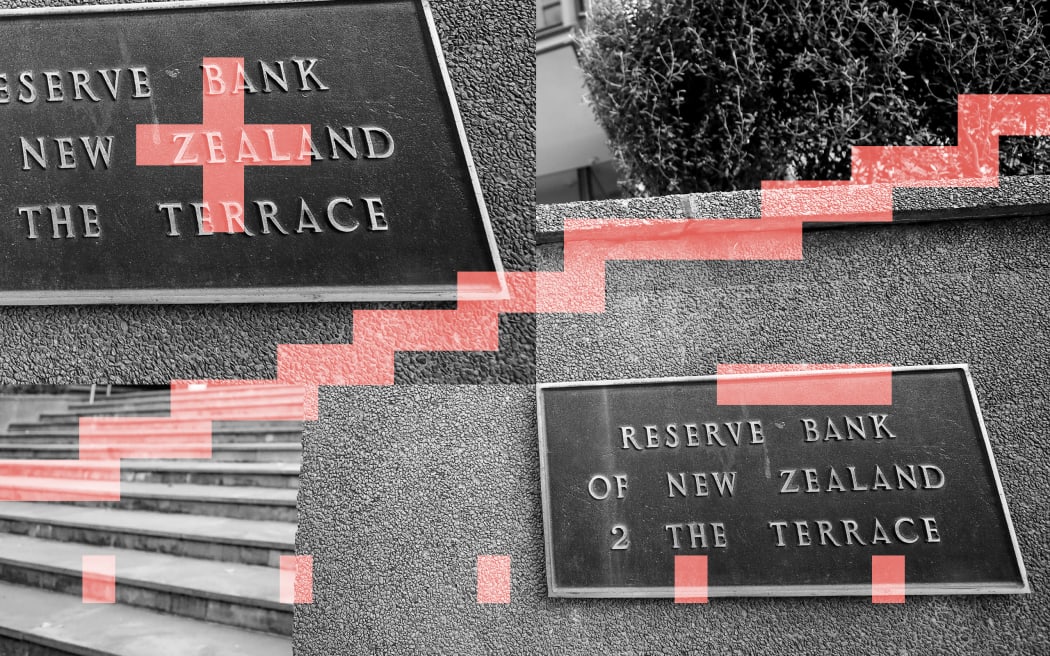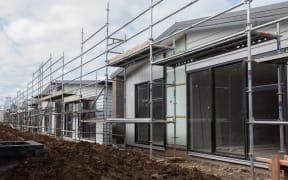
The Reserve Bank's target is to get inflation back between 1 and 3 percent. Photo: RNZ
The easing of the annual inflation to its lowest level in three years might be met with applause, but economists are cautious to celebrate when the underlying figures show there is more to the story.
They say the pressures of domestic inflation - also known as non-tradeable inflation which covers goods and services that do not face foreign competition - are still high and will continue to have an influence and slow the easing in headline inflation.
Pressures on household budgets may, therefore, not ease for a while yet.
But the Reserve Bank's (RBNZ) target is to get inflation back between 1 and 3 percent.
What's inflation again?
Inflation happens when there is a general increase in prices across a wide range of goods and services in the economy. It means money loses its value and buying power over time.
An inflation increase usually happens when demand for goods and services outpaces supply.
RBNZ uses the following example: If more people want to buy houses but there are too few builders or materials, the cost of building goes up because businesses will charge higher prices for their goods or services - as long as customers are willing to pay more.
When this happens more generally in the economy, it is called demand pull inflation.
But there are other reasons prices could increase. For example, storms damaging crop harvests and leading to higher prices in affected foods.
Shipping delays and disruptions can reduce the supply produced overseas, which again can lead to higher goods prices. But in this case, it would be called cost push inflation.
What do the latest figures show?
Annual inflation has eased to its lowest level in nearly three years.
Stats NZ figures showed consumer prices rose 0.6 percent in the three months ended March, taking the annual rate down to 4.0 percent, the lowest since June 2021.
The biggest contributions to the quarterly result came from alcoholic beverages and tobacco (up 3.4 percent, as cigarettes went through their usual annual excise increase), recreation and culture (up 2.4 percent, due to higher prices for accommodation and, to a lesser extent, recreational and cultural services), and housing and household utilities (up 0.7 percent, due to higher rents and residential construction costs).
These elements were also reflected in the annual figures, with the large increases outlined above joined by property rates and related services (up 9.6 percent from a year ago), other recreational equipment and supplies (up 3.6 percent), and alcoholic beverages (up 5 percent).
Transport prices were 2.5 percent lower than in the previous quarter, largely due to a 10 percent decline in international air fares, and falls of 2-4 percent in petrol and diesel prices. Infometrics said at this stage, this fall in fuel prices looked like it would reverse out in the June quarter.

Infometrics says the fall in fuel prices looks like it will reverse out in the June quarter.(file image) Photo:
How high have goods and services' prices increased?
The Consumers Price Index (CPI) is an indicator of how much prices have changed over the year.
Stats NZ record the prices of food, clothing, transport, housing, and about 100,000 different things you can buy or pay for - all of which are combined to make up the CPI.
Rent prices increased 4.7 percent in the year ended March, while construction of new houses and rates increased 3.3 percent and 9.8 percent, respectively.
"Rent prices are increasing at the highest rate since the series was introduced in September 1999," Stats NZ consumers prices senior manager Nicola Growden said.
RBNZ also has an inflation calculator to see how much prices have changed over time.
It shows that a trip to the supermarket which cost about $100 in 2000 would have risen to $194.18 in 2024. So for the same dollars, the consumer's purchasing power had almost halved in that period of time.
The calculator also shows wages have increased by 133.4 percent since 2000.
Overall, the CPI has increased 82.2 percent since 2000 - a 45.4 percent loss in purchasing power.

Rent prices are increasing at the highest rate since September 1999, Stats NZ says. (file image) Photo: RNZ / Nate McKinnon
What are the economists saying?
The numbers were in line with economists' expectations but ahead of the RBNZ forecast of a 0.4 percent quarterly rise and an annual rate of 3.8 percent.
ANZ's economists Henry Russell and Miles Workman said the details showed a much less convincing story of easing inflation than meets the eye.
That is because domestically-generated inflation (5.8 percent year on year) was above their forecast of 5 percent and RBNZ's forecast of 5.3 percent, while tradables inflation (largely imported) came in at 1.6 percent year on year, below ANZ's forecast of 1.9 percent and a touch above the RBNZ's forecast of 1.5 percent.
"Tradables inflation remains weak, as the normalisation in goods prices continues, but with the recent moves higher in oil prices and the re-emergence of shipping disruption likely to add upwards pressure in the coming quarters, there remain plenty of risks to the outlook," ANZ's economists said.
Westpac senior economist Satish Ranchhod agreed, saying domestic price pressures, which were unaffected by official cash rate movements, could be a big concern for RBNZ.
"They don't directly affect things like your council rates or your electricity prices and if those prices are remaining hot, it's going to be make it that harder for them to get inflation back to 2 percent."
The stubborn core was the real concern for the Reserve Bank, he said.
"Importantly, if we look at the domestic inflation components, the underlying rates there are closer to 6 percent, that's got to be a worrying outlook for the RBNZ."

Infometrics chief forecaster Gareth Kiernan Photo: RNZ / Rebekah Parsons-King
Infometrics chief forecaster Gareth Kiernan also agreed the persistence of domestic price pressures would be in the spotlight for RBNZ, because it was still higher than at any time between June 1991 and December 2021.
"As indicated in its recent statement, the bank is acutely aware of other significant price increases occurring that will keep non-tradable inflation elevated this year, including local government rates, insurance, and utility costs. These factors could also slow the easing in headline inflation and inflation expectations.
"Recent immigration policy changes announced by the government will take some time to reduce these housing market pressures. After a sizeable lift in the proportion of items decreasing in price over the second half of 2023, there were fewer price falls again in the March 2024 quarter.
"The proportion of items increasing in price is still above pre-Covid norms, suggesting that there continues to be more acceptance of price rises than the Reserve Bank would be comfortable with."
What are the predictions for this year?
"All up, the Q1 CPI data will be somewhat concerning for the RBNZ. Domestic inflation pressures remain acute, particularly concentrated in services sectors," ANZ's economists said.
"These are the sticky components which are likely to show persistence moving forward and continue to imply a more gradual easing of inflation than the RBNZ have anticipated. Stickiness in this data reinforces our view that cuts are not likely until 2025."
Ranchhod predicted inflation to drop to about 3 percent this year, but that would still mean continued pressure on household budgets.
"Getting it back to 2 [percent], where they want it to be, that's going to take some time longer. I don't think we're going to see that until next year at the earliest.
The longer interest rates stayed high - which he believed was likely for the rest of this year - the more the economy would remain sluggish and unemployment would rise.
In the last month, Infometrics pushed out its expected timing of the first official cash rate from August to November this year.
The figures on Wednesday reinforced their view the RBNZ needed to see more of an easing in domestic inflation before it was comfortable easing monetary policy.
What is RBNZ doing about it?
The Reserve Bank aims to keep inflation low and stable, which helps money keep its value. One of the main tools it uses to try to achieve this is the official cash rate (OCR). This influences how expensive it is to borrow money from the bank.
When inflation is too high, RBNZ raises the cash rate so people spend less and save more - which helps to balance demand for goods and services with supply.
It was confident inflation would be back in the 1-3 percent target band by the end of the year.
The bank also strives to better understand what people think will happen to inflation via surveys to avoid big swings in economic activity.
Reserve Bank chief economist Paul Conway said if workers, businesses and other decision-makers believed inflation would be within target, between 1 and 3 percent, they would be less likely to put up prices or make overly large wage claims.
"Households would also be less willing to accept large price increases and therefore more likely to shop around, which would make it harder for business to increase prices."






